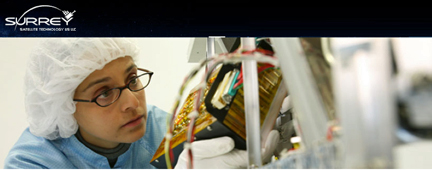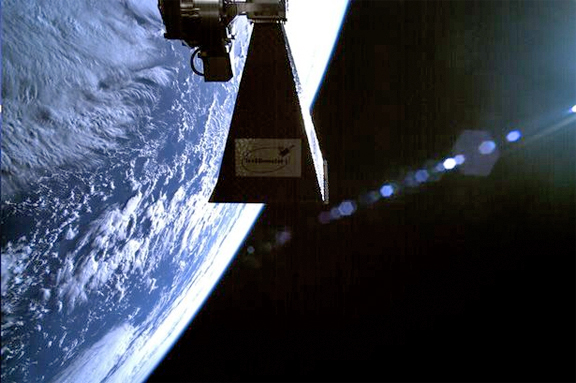
[SatNews] Surrey Satellite Technology Ltd (SSTL) has taken the 'selfie' phenomenon to new heights as a spacecraft has taken a photo of itself to mark the success of a recent launch.

An inspection camera on board the TechDemoSat-1, which was built in Guildford and launched from Kazakhstan earlier this month, took the photo minutes after it separated from the rocket which blasted it into space. The image reveals a view of the Earth from space, with the spacecraft's ‘antenna pointing mechanism' in the shot. The inspection camera which took the image is mounted on the outside of the spacecraft and monitors the behavior of key equipment on board the satellite.
The camera was manufactured by SSTL’s optics experts with off the shelf technologies and combines a color CMOS camera with a high performance machine vision lens. Both the camera and lens were stripped down and strengthened to survive the vibration and shock experienced during launch. The camera system was optimized to give a depth of field capable of delivering an in-focus image of the antenna pointing mechanism and also the Earth in the background.
"The Launch and Early Operations Phase immediately after the launch is the first part of the in-orbit commissioning process for the satellite," a spokesman for SSTL said. "It includes a managed series of tests and operations to check out the functionality of the key operating systems, such as power, communications, propulsion, attitude control and on board computing. TechDemoSat-1 is the first satellite to be controlled by the Satellite Applications Catapult in Harwell, and the commissioning of the platform systems is being performed from there by a team led by SSTL. This satellite is based on the SSTL-150 platform and is part-funded by a grant from the UK’s Technology Strategy Board and South East England Development Agency. The spacecraft carries eight separate payloads from UK academia and industry, providing valuable in-orbit validation for new technologies, and also flies more than 25 new developments for SSTL."
The craft includes a miniature radiation and effects monitor from the Surrey Space Centre, a compact instrument to detect electrons and ions from the Mullars Space Science Laboratory, and an enhanced GPS receiver from SSTL, which will be used to monitor reflected signals to determine ocean roughness.
Further information regarding SSTL is available at http://www.sstl.co.uk/

